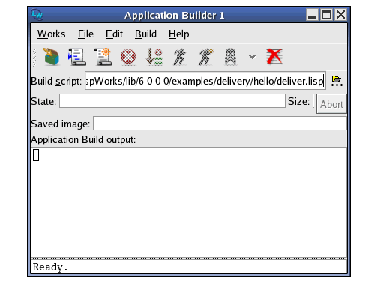 in the Podium.
in the Podium.





The Application Builder makes it easier to create applications, typically by calling deliver. It helps you to control and debug the delivery process. It can also be used to save a development image, calling save-image.
To create an Application Builder, choose
Works > Tools > Application Builder
or click  in the Podium.
in the Podium.
Note: the Application Builder needs deliver (or save-image) functionality and therefore it is not available in LispWorks Personal Edition.
Note: in LispWorks Hobbyist Edition you can use the Application Builder to save a development image, but not to deliver an application.
On first use the Application Builder appears all set to build the CAPI example Hello World, as shown in The Application Builder with the Hello World example below.
Figure 30.1 The Application Builder with the Hello World example


Choose
Build > Build
or click  to build the Hello World example.
to build the Hello World example.
Then choose
Build > Run
or click  to run the Hello World example that you just built.
to run the Hello World example that you just built.
Note that these Application Builder commands are also available on the Build menu.
This tool helps to control and debug the delivery process.
To use the Application Builder, you need to configure it to know about your delivery script, and then invoke the Build command. This runs LispWorks in a subprocess with the script. The Application Builder displays the output, and reports on the progress of Delivery. It also allows you to edit the script, and to run the built application.
Note: the Application Builder runs the build in a subprocess. It does not save the LispWorks IDE image containing the Application Builder tool. The built application contains code loaded by the delivery script, but does not inherit any settings you have made in the LispWorks IDE image.
Note: The Application Builder does not help you in writing your application.
Note: In LispWorks 4.4 and previous versions, you would generally need to write a shell script which runs LispWorks with the appropriate command arguments for delivery. The Application Builder obviates the need for such a script, allowing you to complete the delivery process entirely within the LispWorks IDE.
LispWorks IDE User Guide (Unix version) - 13 Sep 2017